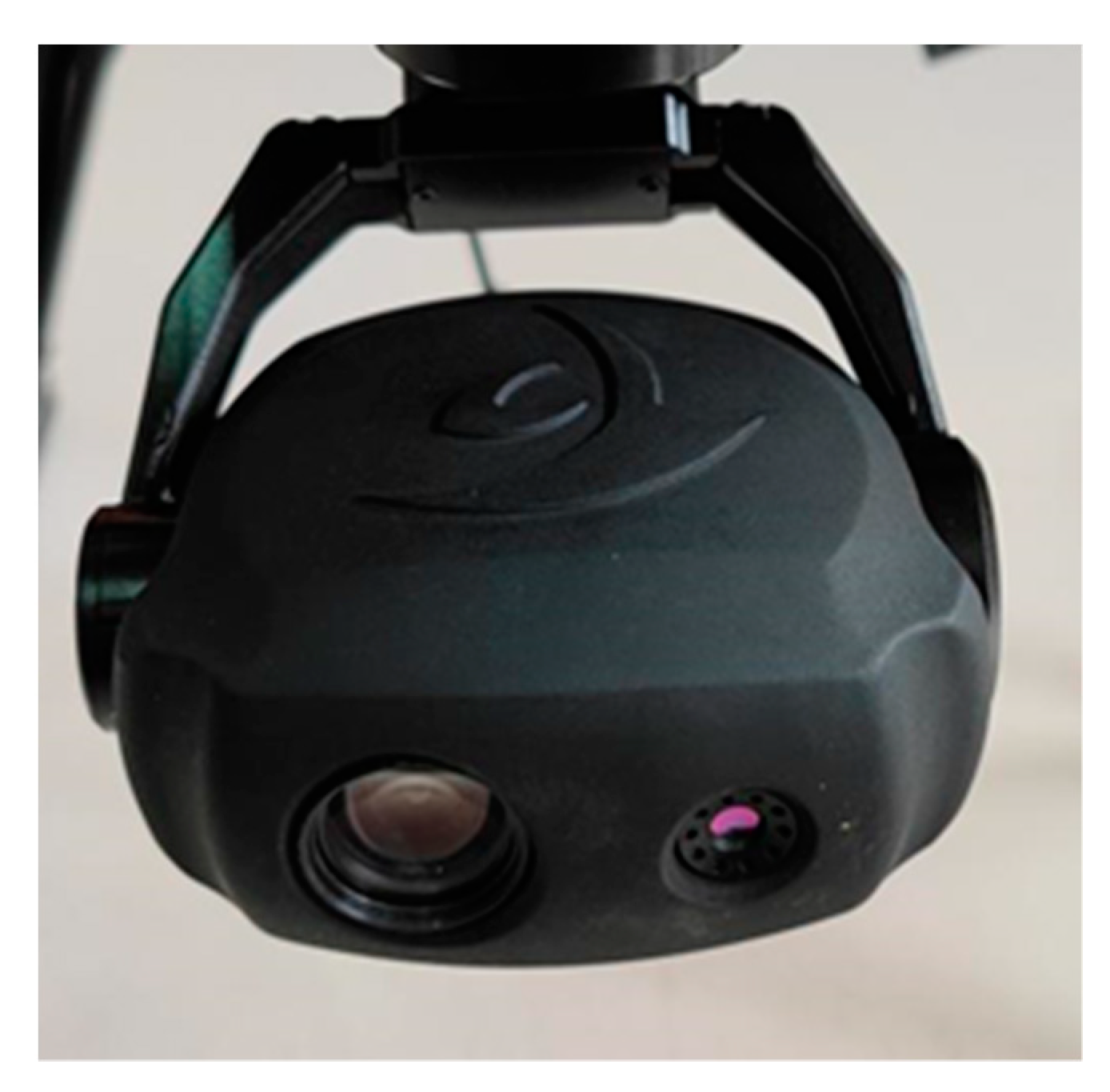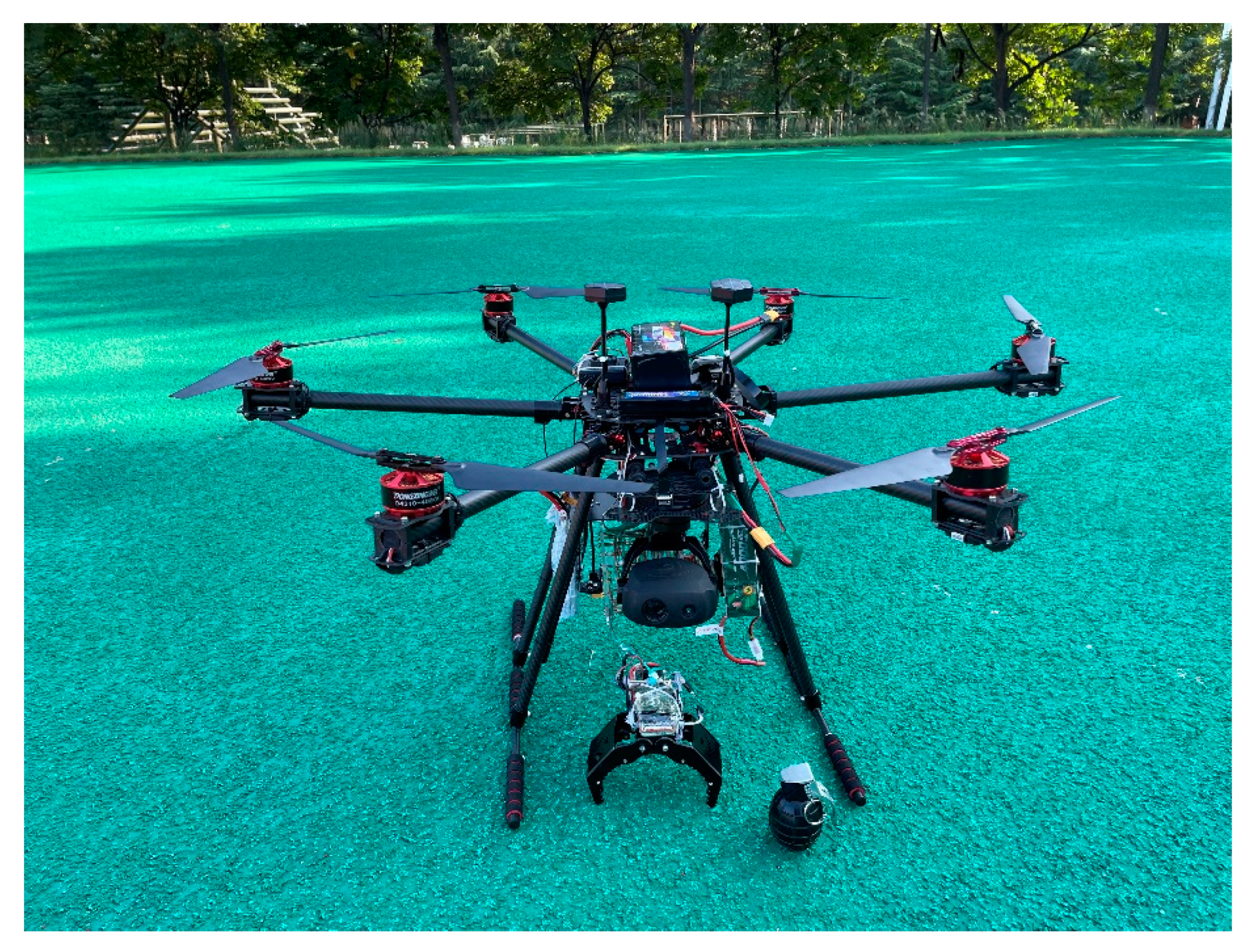Design and Implementation of Intelligent EOD System Based on Six-Rotor UAV
Abstract
:1. Introduction
2. Related Work
3. Our Approach
3.1. Hardware Design
3.1.1. Design of Winch Device
3.1.2. Design of Mechanical Gripper
3.1.3. Dual-Vision-Integrated PTZ Pod
3.2. Software Design
3.2.1. UAV Navigation Control Module
3.2.2. UXO Detection Module
4. Experimental Results and Discussion
5. Conclusions
Author Contributions
Funding
Data Availability Statement
Conflicts of Interest
References
- Mei, Z.; Mei, C.; Tao, Y.; Yao, L. Study of Risk Factors, Organization Method, and Risk Assessment in Troops’ Live Hand Grenade Training. In Proceedings of the Lecture Notes in Electrical Engineering, Lisbon, Portugal, 29–31 July 2016; pp. 481–487. [Google Scholar]
- Medda, A.; Funk, R.; Ahuja, K.; Kamimori, G. Measurements of Infrasound Signatures From Grenade Blast during Training. Mil. Med. 2021, 186, 523–528. [Google Scholar] [CrossRef]
- Potter, A.W.; Hunt, A.P.; Pryor, J.L.; Pryor, R.R.; Stewart, I.B.; Gonzalez, J.A.; Xu, X.; Waldock, K.A.; Hancock, J.W.; Looney, D.P. Practical method for determining safe work while wearing explosive ordnance disposal suits. Saf. Sci. 2021, 141, 105328. [Google Scholar] [CrossRef]
- Barisic, A.; Car, M.; Bogdan, S. Vision-based system for a real-time detection and following of UAV. In Proceedings of the 2019 Workshop on Research, Education and Development of Unmanned Aerial Systems (RED UAS), Cranfield, UK, 25–27 November 2019; pp. 156–159. [Google Scholar] [CrossRef]
- Xi, J.; Wang, C.; Yang, X.; Yang, B. Limited-Budget Output Consensus for Descriptor Multiagent Systems With Energy Constraints. IEEE Trans. Cybern. 2020, 50, 4585–4598. [Google Scholar] [CrossRef] [PubMed] [Green Version]
- Deng, S.; Cai, H.; Li, K.; Cheng, Y.; Ni, Y.; Wang, Y. The Design and Analysis of a Light Explosive Ordnance Disposal Manipulator. In Proceedings of the 2018 2nd International Conference on Robotics and Automation Sciences (ICRAS), Wuhan, China, 23–25 June 2018; pp. 1–5. [Google Scholar]
- Gao, F.; Zhang, H.; Li, Y.; Deng, W. Research on target recognition and path planning for EOD robot. Int. J. Comput. Appl. Technol. 2018, 57, 325. [Google Scholar] [CrossRef]
- Lee, H.J.; Ryu, J.-K.; Kim, J.; Shin, Y.J.; Kim, K.-S.; Kim, S. Design of modular gripper for explosive ordinance disposal robot manipulator based on modified dual-mode twisting actuation. Int. J. Control Autom. Syst. 2016, 14, 1322–1330. [Google Scholar] [CrossRef]
- Xiong, W.; Chen, Z.; Wu, H.; Xu, G.; Mei, H.; Ding, T.; Yang, Y. Fetching trajectory planning of explosive ordnance disposal robot. Ferroelectrics 2018, 529, 67–79. [Google Scholar] [CrossRef]
- Akhloufi, M.; Couturier, A.; Castro, N. Unmanned Aerial Vehicles for Wildland Fires: Sensing, Perception, Cooperation and Assistance. Drones 2021, 5, 15. [Google Scholar] [CrossRef]
- Jo, Y.-I.; Lee, S.; Kim, K.H. Overlap Avoidance of Mobility Models for Multi-UAVs Reconnaissance. Appl. Sci. 2020, 10, 4051. [Google Scholar] [CrossRef]
- Shafique, A.; Mehmood, A.; Elhadef, M. Detecting Signal Spoofing Attack in UAVs Using Machine Learning Models. IEEE Access 2021, 9, 93803–93815. [Google Scholar] [CrossRef]
- Grogan, S.; Pellerin, R.; Gamache, M. The use of unmanned aerial vehicles and drones in search and rescue operations-a survey. Prolog 2018, 2018, 1–13. [Google Scholar]
- Ding, X.; Guo, P.; Xu, K.; Yu, Y. A review of aerial manipulation of small-scale rotorcraft unmanned robotic systems. Chin. J. Aeronaut. 2019, 32, 200–214. [Google Scholar] [CrossRef]
- Lu, R.; Yang, X.; Li, W.; Fan, J.; Li, D.; Jing, X. Robust Infrared Small Target Detection via Multidirectional Derivative-Based Weighted Contrast Measure. IEEE Geosci. Remote Sens. Lett. 2020, 1, 1–5. [Google Scholar] [CrossRef]
- Lu, R.; Yang, X.; Jing, X.; Chen, L.; Fan, J.; Li, W.; Li, D. Infrared Small Target Detection Based on Local Hypergraph Dissimilarity Measure. IEEE Geosci. Remote Sens. Lett. 2021, 1, 1–5. [Google Scholar] [CrossRef]
- Boudjit, K.; Ramzan, N. Human detection based on deep learning YOLO-v2 for real-time UAV applications. J. Exp. Theor. Artif. Intell. 2021, 2021, 1–18. [Google Scholar] [CrossRef]
- Avola, D.; Cinque, L.; Diko, A.; Fagioli, A.; Foresti, G.; Mecca, A.; Pannone, D.; Piciarelli, C. MS-Faster R-CNN: Multi-Stream Backbone for Improved Faster R-CNN Object Detection and Aerial Tracking from UAV Images. Remote Sens. 2021, 13, 1670. [Google Scholar] [CrossRef]
- Liu, Y.; Yang, F.; Hu, P. Parallel FPN Algorithm Based on Cascade R-CNN for Object Detection from UAV Aerial Images. Laser Optoelectron. Prog. 2020, 57, 201505. [Google Scholar] [CrossRef]
- Yang, Y.; Gong, H.; Wang, X.; Sun, P. Aerial Target Tracking Algorithm Based on Faster R-CNN Combined with Frame Differencing. Aerospace 2017, 4, 32. [Google Scholar] [CrossRef] [Green Version]
- Sadykova, D.; Pernebayeva, D.; Bagheri, M.; James, A. IN-YOLO: Real-Time Detection of Outdoor High Voltage Insulators Using UAV Imaging. IEEE Trans. Power Deliv. 2020, 35, 1599–1601. [Google Scholar] [CrossRef]
- Francies, M.L.; Ata, M.M.; Mohamed, M.A. A robust multiclass 3D object recognition based on modern YOLO deep learning algorithms. Concurr. Comput. Pract. Exp. 2021, 23, e6517. [Google Scholar] [CrossRef]
- Liu, T.; Pang, B.; Zhang, L.; Yang, W.; Sun, X. Sea Surface Object Detection Algorithm Based on YOLO v4 Fused with Reverse Depthwise Separable Convolution (RDSC) for USV. J. Mar. Sci. Eng. 2021, 9, 753. [Google Scholar] [CrossRef]
- Kim, J.; Cho, J. A Set of Single YOLO Modalities to Detect Occluded Entities via Viewpoint Conversion. Appl. Sci. 2021, 11, 6016. [Google Scholar] [CrossRef]
- Zhao, Z.; Han, J.; Song, L. YOLO-Highway: An Improved Highway Center Marking Detection Model for Unmanned Aerial Vehicle Autonomous Flight. Math. Probl. Eng. 2021, 2021, 1–14. [Google Scholar] [CrossRef]
- Mittal, P.; Singh, R.; Sharma, A. Deep learning-based object detection in low-altitude UAV datasets: A survey. Image Vis. Comput. 2020, 104, 104046. [Google Scholar] [CrossRef]
- Diez, Y.; Kentsch, S.; Fukuda, M.; Caceres, M.; Moritake, K.; Cabezas, M. Deep Learning in Forestry Using UAV-Acquired RGB Data: A Practical Review. Remote Sens. 2021, 13, 2837. [Google Scholar] [CrossRef]
- Redmon, J.; Divvala, S.; Girshick, R.; Farhadi, A. You Only Look Once: Unified, Real-Time Object Detection. In Proceedings of the IEEE Conference on Computer Vision and Pattern Recognition (CVPR), Las Vegas, NV, USA, 27–30 June 2016; pp. 779–788. [Google Scholar] [CrossRef] [Green Version]
- Redmon, J.; Farhadi, A. Yolov3: An incremental improvement. arXiv 2018, arXiv:1804.02767. [Google Scholar]
- Bochkovskiy, A.; Wang, C.-Y.; Liao, H.-J.M. YOLOv4 Optimal Speed and Accuracy of Object Detection. In Proceedings of the Computer Vision and Pattern Recognition. arXiv 2020, arXiv:2004.10934. [Google Scholar]
- Jia, W.; Xu, S.; Liang, Z.; Zhao, Y.; Min, H.; Li, S.; Yu, Y. Real-time automatic helmet detection of motorcyclists in urban traffic using improved YOLOv5 detector. IET Image Process. 2021, 15, 3623–3637. [Google Scholar] [CrossRef]
- Yao, J.; Qi, J.; Zhang, J.; Shao, H.; Yang, J.; Li, X. A Real-Time Detection Algorithm for Kiwifruit Defects Based on YOLOv5. Electron. 2021, 10, 1711. [Google Scholar] [CrossRef]
- Yan, B.; Fan, P.; Lei, X.; Liu, Z.; Yang, F. A Real-Time Apple Targets Detection Method for Picking Robot Based on Improved YOLOv5. Remote Sens. 2021, 13, 1619. [Google Scholar] [CrossRef]
- Malta, A.; Mendes, M.; Farinha, T. Augmented Reality Maintenance Assistant Using YOLOv5. Appl. Sci. 2021, 11, 4758. [Google Scholar] [CrossRef]
- Liau, Y.Y.; Ryu, K. Status Recognition Using Pre-Trained YOLOv5 for Sustainable Human-Robot Collaboration (HRC) System in Mold Assembly. Sustainability 2021, 13, 12044. [Google Scholar] [CrossRef]















Publisher’s Note: MDPI stays neutral with regard to jurisdictional claims in published maps and institutional affiliations. |
© 2021 by the authors. Licensee MDPI, Basel, Switzerland. This article is an open access article distributed under the terms and conditions of the Creative Commons Attribution (CC BY) license (https://creativecommons.org/licenses/by/4.0/).
Share and Cite
Fan, J.; Lu, R.; Yang, X.; Gao, F.; Li, Q.; Zeng, J. Design and Implementation of Intelligent EOD System Based on Six-Rotor UAV. Drones 2021, 5, 146. https://doi.org/10.3390/drones5040146
Fan J, Lu R, Yang X, Gao F, Li Q, Zeng J. Design and Implementation of Intelligent EOD System Based on Six-Rotor UAV. Drones. 2021; 5(4):146. https://doi.org/10.3390/drones5040146
Chicago/Turabian StyleFan, Jiwei, Ruitao Lu, Xiaogang Yang, Fan Gao, Qingge Li, and Jun Zeng. 2021. "Design and Implementation of Intelligent EOD System Based on Six-Rotor UAV" Drones 5, no. 4: 146. https://doi.org/10.3390/drones5040146
APA StyleFan, J., Lu, R., Yang, X., Gao, F., Li, Q., & Zeng, J. (2021). Design and Implementation of Intelligent EOD System Based on Six-Rotor UAV. Drones, 5(4), 146. https://doi.org/10.3390/drones5040146




